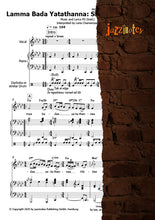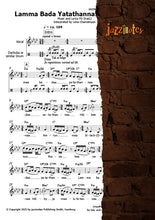
Short Description: Sheet music for Lama Bada Yatathana (also called Lamma Bada Yatathanna or Lamma Bada Yatathana, and in Arabic لما بدا يتثنى) as interpreted by Lena Chamamyan for piano, vocals with lyrics and chord symbols, and optional darbouka (or similar drum). Only the basic drum patterns are notated. The vocals and piano parts are transcribed note-for-note with all ornaments. In addition to the full score (8 pages), a simplified version is included, omitting variations in the repeats (4 pages), as well as the lead sheet (vocal melody and chord symbols above, lyrics below, 2 pages).
Licensed Territory: worldwide
Instrumentation: Piano & Vocal incl. chord symbols + Darbouka (only basic patterns)
Interpreter: Lena Chamamyan
Music & Words by: trad. (from Andalusia during the time of the Moors)
Level: 3 (of 5)
Pages: 14 (8 complete sequence, 4 simplified version, 2 lead sheet)
Order No. 101-600-8002d
Guarantee: yes
Video: Please click on the video icon above!
Songfacts:
Lama Bada Yatathana (Arabic: لما بدا يتثنى, also called Lamma Bada Yatathanna or Lamma Bada Yatathana) is a Muwashshah (Arabic: موشح), an Arabic-Andalusian song in strophic form (a characteristic multi-stanza poem with end rhyme and refrain) using the Nehawand scale (Maqam, Arabic: مقام), which is very similar to the European harmonic minor scale (with the characteristic 1 1/2-tone interval between step 6 and 7). This is likely why the western harmonies, played on a well-tempered piano, sound so organic, even though Arabic music actually seems incompatible with western harmonies. The song originates from Andalusia during the time when it was ruled by the Moors. It probably originated during the Caliphate of Cordoba (929-1031) or at the latest during the Emirate of Granada (1238-1492). It is perhaps the most famous Arabic song in the world. Its characteristic feature is the regular-irregular time, often notated as 10/8 time. In the jazzinotes edition, it is notated as a repeated sequence of 3/4, 4/4, and 3/4 time, totaling 10/4 time. The lyrics (both in Arabic and with Latin transliteration) with translations into English and German can be found in the sheet music, along with an explanation of the three printed versions: 1. Complete original transcription (note-for-note), 2. Simplified arrangement, 3. Lead sheet (with lyrics and chord symbols). Optionally, you will also find the basic patterns for the darbouka drum, which can, of course, also be played on a similar drum.
Lena Chamamyan, born June 27, 1980, is a Syrian-Armenian singer, musician, and composer. Her first album, which also gained recognition in Europe, was released in 2006 under the title Hal Asmar Ellon. The recording of Lama Bada Yatathana comes from her second album, Shamat, released in Lebanon in 2007 and arranged by Basel Rajoub. Lena Chamamyan currently lives in Paris.
Transposition:
We can transpose the score for you. This is how it works:
1. Order it in the original version.
2. Order our article Transposition A.
3. Send an informal email to info@jazzinotes.com (subject: “Transposition”).
In the text of the email please indicate the title of the original as well as the
key desired.
You’ll receive the transposition within a couple of days as a pdf-file you can open using your password for the original version.








